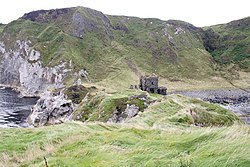Kinbane Castle: Difference between revisions
Created page with "{{Infobox castle |name=Kinbane Castle |county=Antrim |picture=Kinbane Castle, daylight.jpg |picture caption=Kinbane Castle |os grid ref=D08764383 |latitude=55.229167 |longitud..." |
No edit summary |
||
| Line 15: | Line 15: | ||
|ownership=State care | |ownership=State care | ||
}} | }} | ||
'''Kinbane Castle''' lies in ruins on the north coast of [County Antrim]], on a long, narrow limestone headland projecting into the sea, approximately three miles from [[Ballycastle]] on the road to [[Ballintoy]]. It is within the [[townland]] of [[Cregganboy]]. | '''Kinbane Castle''' lies in ruins on the north coast of [[County Antrim]], on a long, narrow limestone headland projecting into the sea, approximately three miles from [[Ballycastle]] on the road to [[Ballintoy]]. It is within the [[townland]] of [[Cregganboy]]. | ||
The name 'Kinbane' is from the Gaelic language: ''Ceinn Bán'' means "White Head", which refers to the white limestone on which the castle stands. | The name 'Kinbane' is from the Gaelic language: ''Ceinn Bán'' means "White Head", which refers to the white limestone on which the castle stands. | ||
Latest revision as of 20:21, 25 October 2017
| Kinbane Castle | |
|
County Antrim | |
|---|---|
 Kinbane Castle | |
| Location | |
| Grid reference: | D08764383 |
| Location: | 55°13’45"N, 6°17’29"W |
| History | |
| Built 1547 | |
| Information | |
| Condition: | Ruin |
| Owned by: | (State care) |
Kinbane Castle lies in ruins on the north coast of County Antrim, on a long, narrow limestone headland projecting into the sea, approximately three miles from Ballycastle on the road to Ballintoy. It is within the townland of Cregganboy.
The name 'Kinbane' is from the Gaelic language: Ceinn Bán means "White Head", which refers to the white limestone on which the castle stands.
Little of the castle remains, and the path up to it is narrow and stepped.
Kinbane Castle is a State Care Historic Monument.[1] The area surrounding Kinbane Castle is a Scheduled Historic Monument.
The site has views of Rathlin Island and Dunagregor Iron Age fort.
History
A two-storey castle was built in 1547 by Colla MacDonnell, brother of the famous, or infamous, Sorley Boy MacDonnell. It was built with a large courtyard with traces of other buildings, probably constructed out of wood.[2] In 1551 the castle was besieged by English forces under Lord Deputy, Sir James Croft, in the course of an expedition against the MacDonnell's. Another siege in 1555 by English forces, the castle was partly destroyed by cannon fire. Rebuilt afterwards, Colla MacDonnell died at the castle in 1558.
The hollow below the castle known as Lag na Sassenach (Hollow of the English) and it was allegedly during the 16th century that a garrison of English soldiers laying siege to the castle were surrounded and massacred. Fires lit on the headland as calls for assistance were answered by clansmen who came from all directions and surrounded the garrison.
Sorley Boy MacDonnell exchanged the castle with another property at Colonsay with Gillaspick MacDonnell, son of Colla MacDonnell. The castle was then presented to the Owen MacIan Dubh MacAllister, 2nd of Loup, Chief of Clan MacAlister as a reward for their service and loyalty to the MacDonnell clan. Owen MacIan Dubh MacAllister was killed in 1571 during a skirmish with the Carrickfergus garrison, fighting alongside Sorley Boy.
The castle remained in the descendants of the MacAllisters of Kenbane until the 18th century.[3]

Outside links
- History and pictures of Kinbane Castle at The Northern Ireland Guide
- 360° Virtual Tour of Kinbane Castle at Virtual Visit Tours Ireland
References
- ↑ Schedule of State care monuments
- ↑ "Kenbane Castle". 2009. http://www.castles.nl/kinbane-castle. Retrieved 2009-07-03.
- ↑ Castles NI: Kenbane Castle